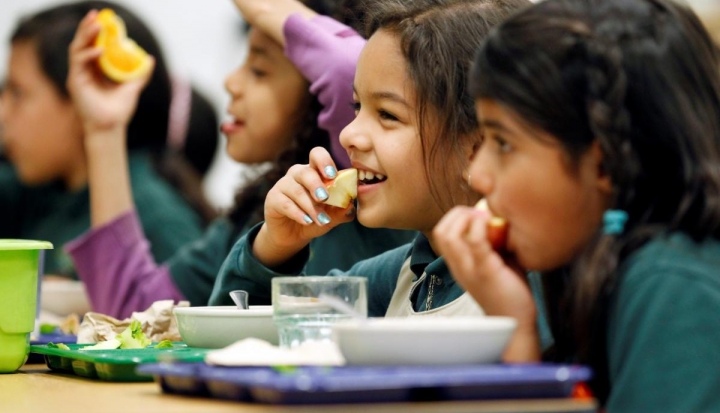School lunchrooms all smell and look the same, the overripe aroma of hundreds of lunches barely contained by cream-colored walls just this side of salmon. Every table is a petri dish despite the wipe-and-spray done by careless seventh graders more interested in squirting the back of each other’s pants than sanitizing eating surfaces.
Sadder, though, than any of the smells or sounds is the sight of children clamoring for seats next to their favorite friends, the pecking order of elementary school life painfully visible on any given day of the week. I brought lunch to my third grader this week and bore witness to this unspoken reckoning of elementary social life.
The two tables designated for his class filled quickly and noisily. In the melee of clattering trays and rustling bags, one of the kids was elbowed out of available seats and unwrapped his lunch at a wide open table where he was the only occupant. I didn’t notice at first because the cacophony of the lunchroom overwhelmed me, but when I did, I leaned down and asked Atticus if his classmate always ate by himself.
My son did a bang-up job of not answering me, distracted as he was with dangling hot French fries in front of his friends and their homemade lunches. Ever so often, he threw a fry into the center of the table to watch his friends descend on it like jackals. They all laughed. Third graders are weird.
I pushed my question again, this time putting my face in front of his. “Does he always eat by himself?”
Atticus shrugged, muttered a noncommittal, “Dunno,” then returned to his jackal baiting.
In that moment, I felt stuck. For an 8-year-old boy, my son is fairly sensitive, but I could see in this situation he was choosing not to be empathetic, moving forward instead on that tidal wave of social stratification that defines elementary school life. I went home determined to find a way to strengthen my son’s empathy muscles.
I knew talking at him was not going to have the radical effect I wanted, so I took to the Internet and found a wealth of resources to help generate the sort of conversation we needed. Countless videos presented themselves, like the incredibly moving Thai commercial that so poignantly illustrates the beauty of the accumulation of small acts of kindness. But I wanted a quieter, more introspective approach, so I searched for books on empathy.
Building a library of books that promote empathy and sharing them with my kids proved to be a joyful experience. We climbed into my son’s bed with a pile of them cascading around us. They were all geared toward younger kids, unlike the chapter books demanded of him at his age, so he was pretty thrilled to return to that golden era of picture books for a while. The ones we enjoyed the most were Last Stop on Market Street by Matt de la Pena, Enemy Pie by Derek Munson, and Rhino in the House by Daniel Kirk, but it was The Invisible Boy by Trudy Ludwig that got straight to the problem.
The Invisible Boy centers on Brian, a young boy who is invisible to his classmates day after day, never included in playground games nor spoken to at lunchtime. The illustrations reinforce his unnoticed existence, as Brian is merely a black-and-white sketch while everyone else is in full color. A show of empathy on Brian’s part to new kid Justin sparks a friendship between them, and slowly Brian’s life and illustration becomes vivid and colorful.
As we read the book, my son frequently interjected with comments like, “Oh, that’s sad!” When we were finished, I asked him if Brian reminded him of anyone. “Not really,” he answered.
“What about the kid who was sitting by himself at lunch the other day?” I pushed.
“He never sits by himself.”
“What do you mean? I saw him. He was at that big table by himself when I brought you lunch.”
“That never happens. I promise,” my son insisted.
And that’s when it occurred to me. It wasn’t my son who needed empathy training. I was the one who had bumped the kid from the table, my presence making one less seat available in the lunchroom that day. I was the one who was blind to the situation, not my son or his friends.
That it had taken me days to realize this only made my lack of awareness more egregious. Here I was all high and mighty setting out on this mission to teach my son a grand lesson when it was me who needed to open my eyes and see things in full color. I guess when it comes to strengthening our empathy muscles, we are never too old for the kind of reminders a children’s book can give us.
We’ve continued reading the collection of books on empathy we started that day, and added Wonder by R.J. Palacio, The Hundred Dresses by Eleanor Estes, and Hey, Little Ant by Phillip and Hannah Hoose to our must-read list. With any luck, maybe next time we’re in the school lunchroom, at least one of us will have become a better, more empathetic person.
Molly Jo Rose’s column, In and Of the World, focuses on finding God’s goodness in the darkest places of the world.
Image: Flickr cc via U.S. Department of Agriculture











